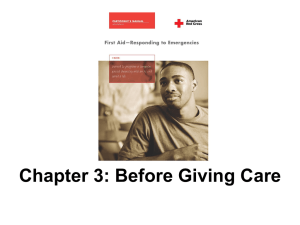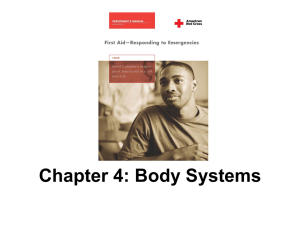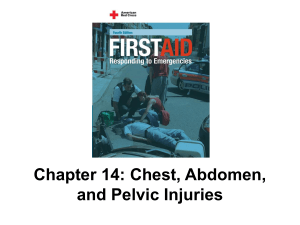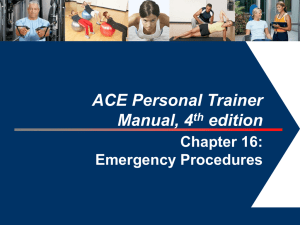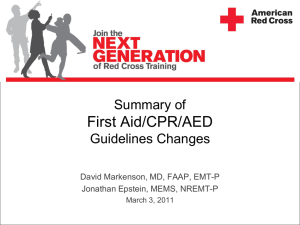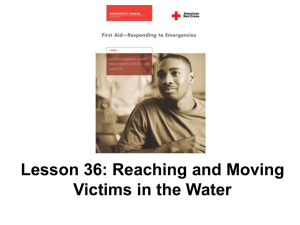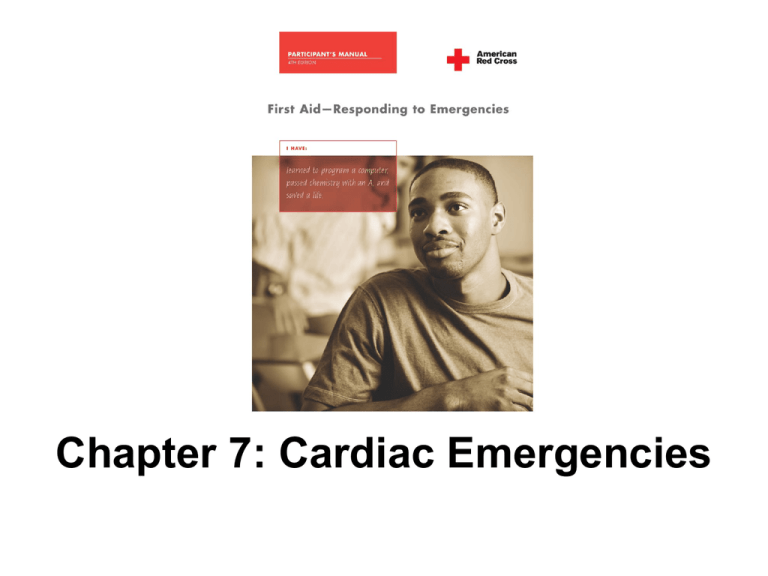
Chapter 7: Cardiac Emergencies
Terminology
Cardiovascular disease
Coronary heart disease
Heart attack (myocardial infarction)
Cardiac arrest
2
AMERICAN RED CROSS FIRST AID–RESPONDING TO EMERGENCIES FOURTH EDITION
Copyright © 2006 by The American National Red Cross
All rights reserved.
Cardiac Chain of Survival
Cardiopulmonary resuscitation (CPR) is a combination of chest
compressions and rescue breathing.
Cardiac Chain of Survival:
Early recognition and early access
Early CPR
Early defibrillation
Early advanced medical care
3
AMERICAN RED CROSS FIRST AID–RESPONDING TO EMERGENCIES FOURTH EDITION
Copyright © 2006 by The American National Red Cross
All rights reserved.
Recognizing Signals of a Heart Attack
Heart attacks are caused by an
obstruction in the coronary arteries.
This blockage leads to death of the
heart muscle.
Pain is described as—
Uncomfortable pressure.
Squeezing.
Crushing.
Tightness.
Aching.
Constricting.
Heavy sensation in the chest.
4
AMERICAN RED CROSS FIRST AID–RESPONDING TO EMERGENCIES FOURTH EDITION
Copyright © 2006 by The American National Red Cross
All rights reserved.
Recognizing Signals of a Heart Attack
(continued)
Any severe chest pain, pain lasting longer than 3 to 5 minutes or
chest pain accompanied by other signals of a heart attack should
receive emergency medical care immediately.
Other signals include—
Trouble breathing.
Paleness.
Ashen skin or bluish skin, particularly around the face.
Skin may also be moist.
5
AMERICAN RED CROSS FIRST AID–RESPONDING TO EMERGENCIES FOURTH EDITION
Copyright © 2006 by The American National Red Cross
All rights reserved.
Recognizing Signals of a Heart Attack
(continued)
As with men, women’s most common heart attack signal is chest
pain or discomfort.
Women are somewhat more likely to experience other warning
signals, particularly—
Shortness of breath.
Nausea or vomiting.
Back or jaw pain.
6
AMERICAN RED CROSS FIRST AID–RESPONDING TO EMERGENCIES FOURTH EDITION
Copyright © 2006 by The American National Red Cross
All rights reserved.
Care for a Heart Attack
Follow CHECK—CALL—CARE.
Call 9-1-1 or the local emergency number.
Have the victim stop all physical activity.
Loosen any restrictive clothing and have the victim rest.
Monitor the victim closely.
Be prepared to perform CPR or use an AED.
Talk to bystanders to find out what happened.
Assist the victim.
Do not try to drive the victim to the hospital yourself.
Demonstrate a calm, reassuring manner.
7
AMERICAN RED CROSS FIRST AID–RESPONDING TO EMERGENCIES FOURTH EDITION
Copyright © 2006 by The American National Red Cross
All rights reserved.
Angina Pectoris
Narrowing/spasm of coronary arteries decrease oxygen to
heart muscle tissue.
Angina is the resulting pain associated with the oxygen debt.
Angina seldom lasts longer than 3 to 5 minutes.
Nitroglycerin temporarily widens the arteries and therefore
helps relieve the pain.
If there is no relief after 10 minutes, call for help.
8
AMERICAN RED CROSS FIRST AID–RESPONDING TO EMERGENCIES FOURTH EDITION
Copyright © 2006 by The American National Red Cross
All rights reserved.
Cardiac Arrest
Absent or ineffective heart beat
A victim in cardiac arrest is unconscious and shows no signs of
life.
Signs of life include—
Normal breathing.
Movement.
A pulse (for children and infants only).
The victim’s skin may be pale, ashen or bluish, particularly
around the face. The face may also be moist from perspiration.
In some cases, a victim of cardiac arrest may not have shown any
warning signals. This condition is called sudden death.
9
AMERICAN RED CROSS FIRST AID–RESPONDING TO EMERGENCIES FOURTH EDITION
Copyright © 2006 by The American National Red Cross
All rights reserved.
Chapter 7-2: CPR &
Unconscious Choking
Cardiopulmonary Resucitation
If cardiac arrest:
Unconscious
Not breathing
Shows no signs of life
Then perform:
CPR = 30 compressions and 2 breaths for an adult.
11
AMERICAN RED CROSS FIRST AID–RESPONDING TO EMERGENCIES FOURTH EDITION
Copyright © 2006 by The American National Red Cross
All rights reserved.
Unconscious Choking—Adult
The most common cause of obstruction in an unconscious person
is the tongue.
The care for an unconscious choking adult is very similar to the
skill of adult CPR.
Chest compressions are used to help force air from the victim’s
lungs to dislodge a foreign object.
12
AMERICAN RED CROSS FIRST AID–RESPONDING TO EMERGENCIES FOURTH EDITION
Copyright © 2006 by The American National Red Cross
All rights reserved.
Closing
When performing CPR on an adult, give 30 chest compressions,
followed by 2 breaths, at a rate of about 100 compressions per
minute.
The care for an airway obstruction for an unconscious adult is to
give CPR and check for an object in the mouth.
Questions?
13
AMERICAN RED CROSS FIRST AID–RESPONDING TO EMERGENCIES FOURTH EDITION
Copyright © 2006 by The American National Red Cross
All rights reserved.
Chapter 7-3: Adult AED
(Automated External Defibrillation)
Types of AEDs
15
AMERICAN RED CROSS FIRST AID–RESPONDING TO EMERGENCIES FOURTH EDITION
Copyright © 2006 by The American National Red Cross
All rights reserved.
Citizen Responder and AED
Most victims of sudden cardiac arrest need an electric shock,
called defibrillation.
Each minute that defibrillation is delayed reduces the victim’s
chances of survival by about 10 percent.
The sooner the shock is administered, the greater the
likelihood of the victim’s survival.
16
AMERICAN RED CROSS FIRST AID–RESPONDING TO EMERGENCIES FOURTH EDITION
Copyright © 2006 by The American National Red Cross
All rights reserved.
Automated External Defibrillation
Disease or injury can disrupt the heart’s electrical system
and damage the heart.
An automated external defibrillator (AED) is a machine that
analyzes the heart’s rhythm and, if necessary, tells you to
deliver a shock to a victim of a sudden cardiac arrest.
This shock, called defibrillation, may help the heart
reestablish an effective rhythm.
Defibrillation is not intended to restart a heart without any
electrical activity.
17
AMERICAN RED CROSS FIRST AID–RESPONDING TO EMERGENCIES FOURTH EDITION
Copyright © 2006 by The American National Red Cross
All rights reserved.
Safety Precautions When Using an AED
When using an AED, follow these precautions:
Do not touch the victim while the AED is analyzing.
Do not touch the victim while defibrillating.
Do not use alcohol to wipe the victim’s chest dry.
Do not defibrillate someone around flammable materials.
Do not use an AED in a moving vehicle.
Do not use an AED on a victim in contact with water.
Do not use an AED and/or electrode pads designed for
adult victims on an infant or a child under age 8 or
weighing less than 55 pounds.
18
AMERICAN RED CROSS FIRST AID–RESPONDING TO EMERGENCIES FOURTH EDITION
Copyright © 2006 by The American National Red Cross
All rights reserved.
Safety Precautions When Using an AED
(continued)
Do not use an AED on a victim wearing a nitroglycerin
patch or other patch on the chest.
Do not use a mobile phone or conduct radio transmission
within 6 feet of the AED.
Do not place the pads directly over a pacemaker or other
implanted device.
19
AMERICAN RED CROSS FIRST AID–RESPONDING TO EMERGENCIES FOURTH EDITION
Copyright © 2006 by The American National Red Cross
All rights reserved.
Skill Practice and Scenarios
Now it is time to practice!
20
AMERICAN RED CROSS FIRST AID–RESPONDING TO EMERGENCIES FOURTH EDITION
Copyright © 2006 by The American National Red Cross
All rights reserved.

